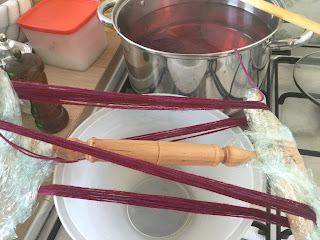I have two daughters - 3 and 7 years old - and both have an inexplicable love for amost all shades pink. So when I started dyeing again this year, one question came up pretty much right away: "Mum, can you also dye pink yarn with plants?". I said I'd look into it...
Avocado seems promising, and as I have mentioned before (when I managed to dye that pretty peach yarn), I will have to conduct extensive research on the subject... but that means eating lots of avocados first. So while I am saving up avocado pits and skins for the next couple of weeks - why not try some other plants that are said to produce pink dyes.
I found several accounts of a "rose, lavender, mint and lemon" dye that will give you pink. What I couldn't find was an actual dye recipe...
Time for an experiment.
Questions:
- I know that rose petals alone should give me some kind of yellow on wool, no idea about the lavender... probably something with a green tinge?
- The addition of lemon juice does make sense to me... lots of dyes are pH sensitive, so shifting the pH value in any direction can have surprising effects. But what difference will the mint make?
Supplies & Materials:
5 big(-ish) jars (with lids)
5 BFL fibre samples (à 20 g), pre-mordanted with alum (15% WoF)
5 cotton fabric samples (50 cm x 50 cm), pre-mordanted with alum (15% WoF)
5 tablespoons (preferably ones that you only use for dyeing)
100 g dried rose petals (mine were not the newest... I was just hoping they would work)
100 g dried lavender flowers
juice of 1 fresh lemon
10g fresh mint leaves
pH indicator strips
an oven
Preparing the dyes
Fill the jars with...
Jar 1: 40 g rose petals
Jar 2: 40 g lavender flowers
Jar 3: 20 g rose petals + 20 g lavender flowers
Jar 4: 20 g rose petals + 20 g lavender flowers + 4 tbsp lemon juice
Jar 5: 20 g rose petals + 20 g lavender flowers + 4 tbsp lemon juice + 10 g fresh mint leaves
then add hot water, stir and put the jars into the oven for a good hour at about 90°C.
Let the dye cool and strain the plant material from the dye baths.
Different colours of the dye baths should are apparent - the fluid in jars 1, 2 and 3 were different shades of reddish brown (jar 2 with a slight hint towards purple)...
jars 4 and 5 looked very definitely red, 5 leaning slightly towards orange.
The dyes in jars 1, 2 and 3 were almost pH neutral at 6,5. The dyes in jars 4 and 5 were acidic at pH around 4 due to the addition of the lemon juice.
Dye Process
I put one wool sample into each of the jars, and filled them up to make sure the wool is covered (see pictures above). Then I put them in the oven at around 90° for a couple of hours, and let them cool over night.
I did the same with the fabric samples the next day.
After taking the samples out of the dye bath I let them dry before rinsing.
Results
This experiment turned out to be a perfect example of how much the resulting colour depends on the fibre.
Here's how the dyes turned out on wool (jars 1 to 5 in order from left to right):
The results in all the jars that contained rose petals were shades of yellow. They are nice yellows, but nothing out of the ordinary, really. My daughter claims that she does see a very faint hint of pink in the samples dyed in jars 4 and 5 - I'd say the do lean towards a warmer yellow with a slight orange tinge. My suspicion that lavender on its own will yield a green tinge was confirmed. It's actually a very pleasant light green...
A lot more variety in colour can be found on the cotton samples (again, jars 1 to 5 in order from left to right):
You can see from the drying picture above - which was taken before rinsing, that quite a bit of colour did wash out in the rinsing process, but I was delighted to find that some colour did stay on!
Jars 1 and 3 gave me shades of light brown.
Lavender really was a pleasant surprise on cotton - yielding a truly beautiful light green tone.
And yes! We do see pink! Jar 4 (rose + lavender + lemon) yielded a very clear light pink tone, while the mint in jar 5 seemed to mute the pink a little bit toward a dustier shade with a slightly orange tinge.
And just for comparison - cotton and wool together:
Notes for future experiments
I am definitely interested in further rose dye experiments on cotton yarn and fabric. So here are some ideas:
- I have read that mordanting with aluminum formate yields better dye results for plant dyes on cotton than mordanting with alum. Must try that...
- I would have loved to have a 6th and 7th jar for rose + lemon and rose + lemon and mint, but I did not have enough rose petals for another two jars... will buy more rose petals...


















































